|
Over the next couple weeks we will dive into why therapists utilize therapeutic modalities during treatment? How these modalities could be beneficial to your rehab and when they are the most effective during treatment?We start off the series understanding myofascial cupping. Series 1 - Myofascial CuppingIt is important to stress that this is not a exhaustive list of contraindications for cupping and when seeking new treatment modalities it is important you receive direction from a certified therapist or health care provider. The basic rule for cupping techniques is to use common sense when determining if an area should be cupped. In general if an area is safe to massage in theory you should also be able to use cups. For practitioners trained in the use of cupping it is important to note that the skill level or competency of the individual practitioner plays a role in whether or not an area can be treated. Below is a list of contraindications for cupping: - malignant tumours - acute musculoskeletal injuries - low blood pressure or other acute circulatory conditions - superficial blood vessels e.g. inside forearm, anterior neck, varicose veins - cupping during pregnancy should be cupped gently in specific areas - elderly and children should be cupped gently - diabetes and medicated for blood thinning - duration should not exceed 10 minute for a stationary cup - light cupping shoulder be used over the spine depending on the mass of the tissue - herniated and bulging discs should not have stationary cups on the spinous processes - extreme cold - open wounds - acute rheumatoid arthritis, fibromyalgia, automimmune - healing fractures - hypersensitivity of the skin - anuerysm - haematoma - sutures - acute venous disease - high temperature - deep vein thrombosis (DVT) - infectious disease Cupping Applications and Benefit
Next week we will review some of the scientific literature on cupping…. Curious if cupping would be a beneficial addition to your therapeutic treatment. Add cupping for free to your 60 or 90 minute massage therapy treatment for the month of September.
0 Comments
Over the next couple weeks we will dive into why therapists utilize therapeutic modalities during treatment? How these modalities could be beneficial to your rehab and when they are the most effective during treatment? We start off the series understanding myofascial cupping. Series 1 - Myofascial CuppingWhat is Myofascial Cupping?Cupping has been used for Centuries but more recently was made popular by professional athletes. Cupping refers to the application of domed cups applied to the skin and removal of the air within the cup to create a suction. This is often done by drawing the air out but can also be removed with heat. As the cups are applied the skin is pulled into the cup and the cup is held in place.
Cupping mimics a number of manual treatment techniques utilized by therapists that include pinching, rolling and tool scraping. The intensity of the cupping can vary and often the technique of cupping is individualized to the treating therapist. History of CuppingCupping has been recorded to have started in 281-341 A.D by an Ge Hong, a Taoist alchemist and herbalist. This initial form of cupping was used for draining wounds and originally used animal horns. Later the Chinese Dynasty would use this application in therapeutic treatment of headaches, dizziness, and abdominal pain. Cups were made of pottery or bamboo and were used for both cold and hot applications. The cups would be applied to the skin over acupuncture needles. Today’s cupping utilizes glass, plastic, or silicone cups. These cups were an improvement on the previous types as they were less likely to break and you are able to view the skin under the cup during treatment. Glass cups use fire to remove the air with-in the cup. The cups interior is rubbed with alcohol then set a light before being placed onto the skin. Silicone cups are depressurized by pressing down onto the top of the dome and plastic cups have a vacuum attachment to remove the air. Next week we will cover the contraindications of cupping as well as the health benefits…. Curious if cupping would be a beneficial addition to your therapeutic treatment. Book an appointment today! NOTE: Please seek a professional diagnosis and discontinue the tests suggested if you have an increase in symptoms. This is only meant as a guide. We do not diagnosis. Are you suffering from numbness and tingling in your hands and fingers? Do you have general aches in your shoulder, elbow or wrist? This discomfort is often intermittent or moves around. You could describe the pain like a tooth ache but you don’t find that the site itself is tender to the touch. Do you suffer from chronic neck and upper back tightness? You could have a nerve impingement, tension or entrapment. Often times neural tension is diagnosed as carpal tunnel syndrome, tennis elbow, golfer’s elbow, or shoulder impingement. If you have been receiving treatment for any of these but have not been getting the results you want try this simple test at home to find out if you have neural tension. Start with an Upper Limb Tension Test. Follow the step by step guide to help determine if could benefit from neural tension treatment as part of your health and fitness routine. Book an Athletic Therapy or Massage Therapy appointment today if you would like to be walked through this testing and receive treatment. Upper Limb Tension Test # 1 - Median Nerve TestBe sure to be sitting upright and comfortable. Bring the right ear towards the right shoulder. Be sure to only have a light stretch in the neck. There should be no pinching in the neck. If there is you have gone to far into the stretch. Bring the left arm up to shoulder height. Extend at the left wrist and fingers. Slowly extend the left arm back maintaining the left hand at shoulder height. Stop movement when you start to feel a stretch. Try on the opposite side. Compare right and left. You could feel tension anywhere between the left shoulder to the left finger tips but is most commonly felt at the elbow, wrist or middle finger.
If you tested positive with the nerve tension test….NOW WHAT… Good news you can work on improving neural tension the same way you can work on mobility of a joint or flexibility of a muscle. Check out our YouTube Channel to view our new nerve flossing videos to improve neural tension or book an appointment and receive an in person treatment or virtual guidance. NOTE: Please seek a professional diagnosis and discontinue the tests suggested if you have an increase in symptoms. This is only meant as a guide. We do not diagnosis. Are you suffering from numbness and tingling in your hands and fingers? Do you have general aches in your shoulder, elbow or wrist? This discomfort is often intermittent or moves around. You could describe the pain like a tooth ache but you don’t find that the site itself is tender to the touch. Do you suffer from chronic neck and upper back tightness? You could have a nerve impingement, tension or entrapment. Often times neural tension is diagnosed as carpal tunnel syndrome, tennis elbow, golfer’s elbow, or shoulder impingement. If you have been receiving treatment for any of these but have not been getting the results you want try this simple test at home to find out if you have neural tension. Start with an Upper Limb Tension Test. Follow the step by step guide to help determine if could benefit from neural tension treatment as part of your health and fitness routine. Book an Athletic Therapy or Massage Therapy appointment today if you would like to be walked through this testing and receive treatment. Upper Limb Tension Test # 2 - Radial Nerve Test
2. Bring your arm forward and rotate the wrist so your palm is facing back. Flex at the wrist 3. Bring your arm forward and rotate the wrist so your palm is facing back. Flex at the wrist 4. Try on the opposite side. Compare right and left. You could feel tension anywhere between your shoulder and fingers. Tension is usually felt at the back of the hand/wrist or outside elbow.
If you tested positive with the nerve tension test….NOW WHAT… Good news you can work on improving neural tension the same way you can work on mobility of a joint or flexibility of a muscle. Check out our YouTube Channel to view our new nerve flossing videos to improve neural tension or book an appointment and receive an in person treatment or virtual guidance. |
AuthorRozalind Sorensen Archives
December 2022
Categories |
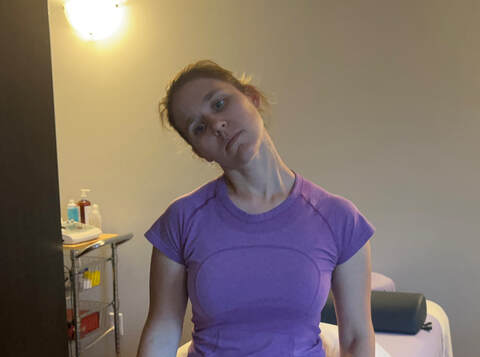
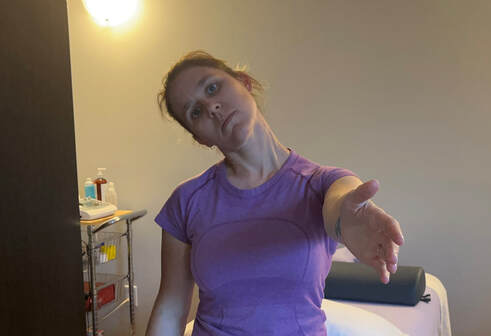
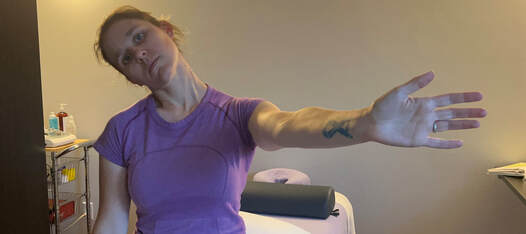
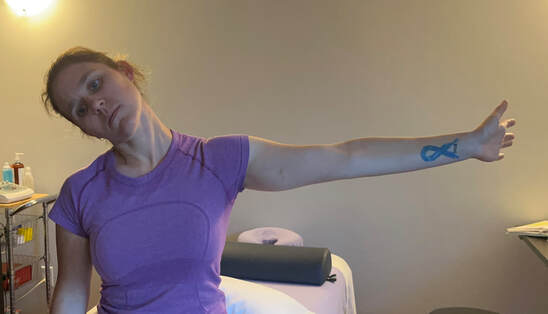
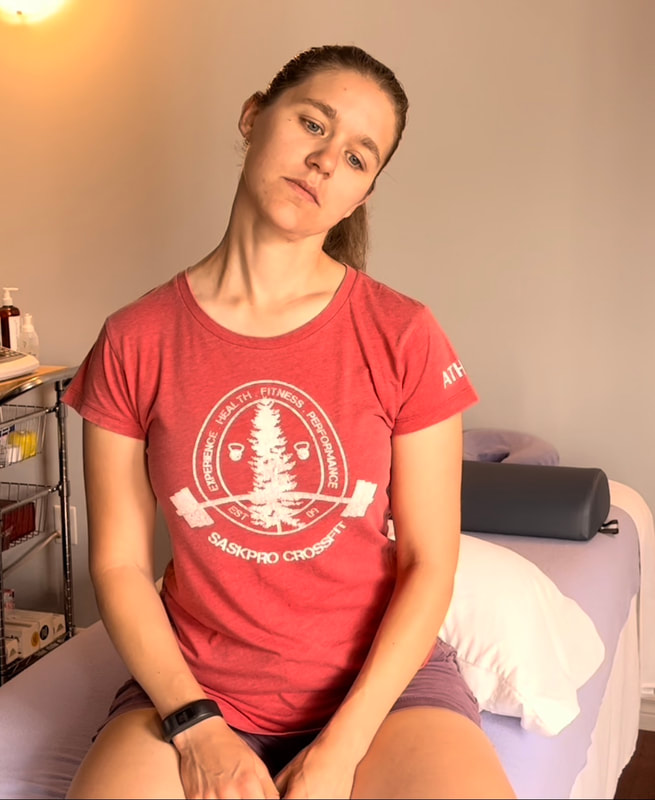
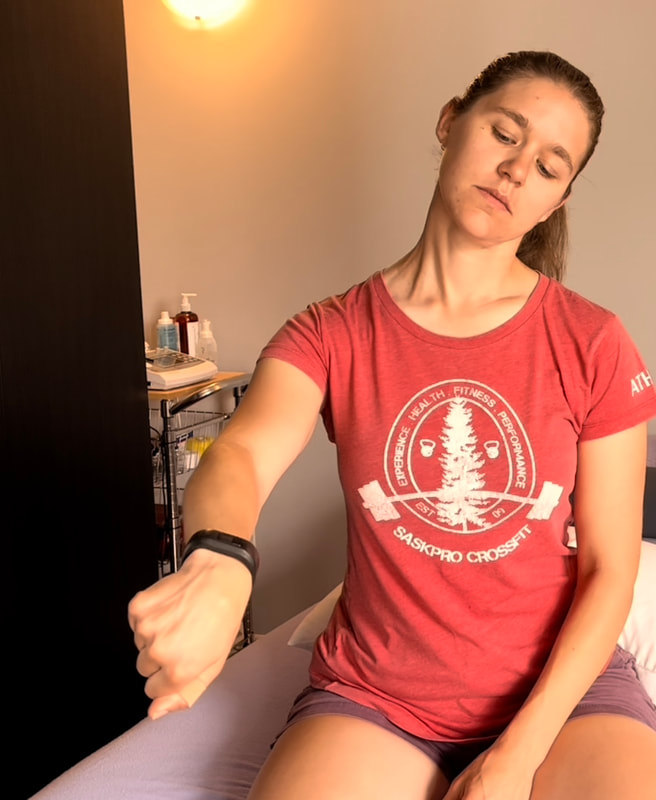
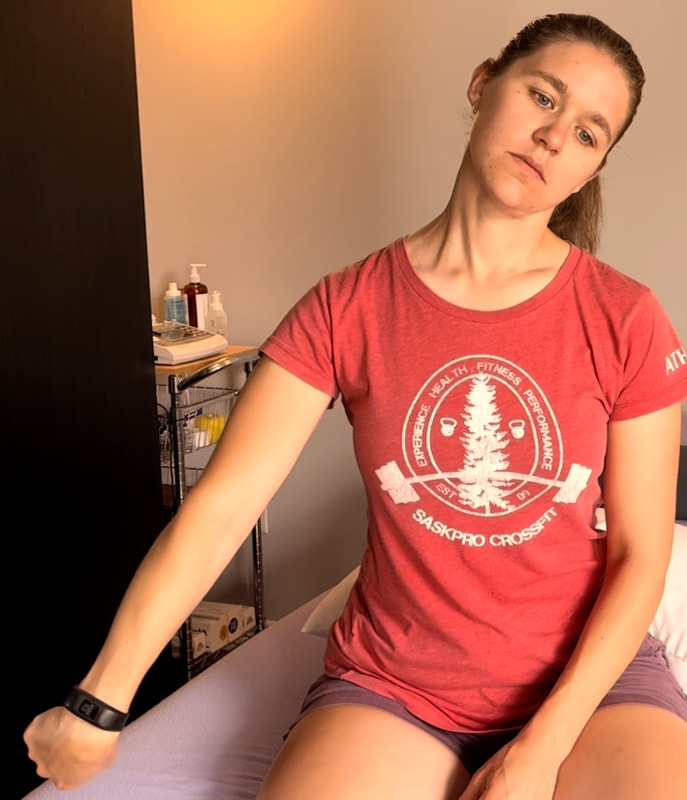
 RSS Feed
RSS Feed